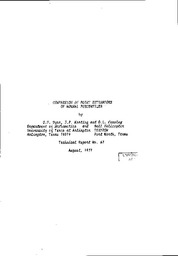
ATTENTION: The works hosted here are being migrated to a new repository that will consolidate resources, improve discoverability, and better show UTA's research impact on the global community. We will update authors as the migration progresses. Please see MavMatrix for more information.
Show simple item record
| dc.contributor.author | Dyer, Danny D. | en |
| dc.contributor.author | Hensley, Onas L. | en |
| dc.contributor.author | Keating, Jerome P. | en |
| dc.date.accessioned | 2010-06-03T16:08:58Z | en |
| dc.date.available | 2010-06-03T16:08:58Z | en |
| dc.date.issued | 1977-08 | en |
| dc.identifier.uri | http://hdl.handle.net/10106/2296 | en |
| dc.description.abstract | **Please note that the full text is embargoed** ABSTRACT: There are available several point estimators of the percentiles
of a normal distribution with both mean and variance unknown. Consequently, it would seam appropriate to make a comparison among the estimators through sums "closeness to the true value" criteria. Along these lines, the concept of Pitman-closeness efficiency is introduced. Essentially, when comparing two estimators, the
Pitman-closeness efficiency gives "odds" in favor of one of the
estimators being closer to the true value than is the other in a given situation. Through the use of Pitman-closeness efficiency, this paper compares (a) the maximum likelihood estimator,
(b) the minimum variance unbissed estimator, (c) the best invariant estimator, and (d) the median unbiased estimator within a class of estimators which includes (a), (b), and (c). Mean squared
efficiency is also discussed. | en |
| dc.language.iso | en_US | en |
| dc.publisher | University of Texas at Arlington | en |
| dc.relation.ispartofseries | Technical Report;67 | en |
| dc.subject | Fatigue life | en |
| dc.subject | Pitman-closeness efficiency | en |
| dc.subject | Mean squared efficiency | en |
| dc.subject | Point estimators | en |
| dc.subject.lcsh | Statistics | en |
| dc.subject.lcsh | Mathematics Research | en |
| dc.title | Comparison of Point Estimators of Normal Percentiles | en |
| dc.type | Technical Report | en |
| dc.publisher.department | Department of Mathematics | en |
Files in this item
- Name:
- MathTechReport067.pdf
- Size:
- 760.5Kb
- Format:
- PDF
- Description:
- PDF
This item appears in the following Collection(s)
Show simple item record


